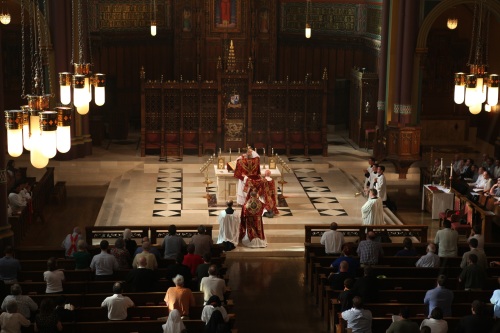I have already given my general impressions and thoughts
about the Sacred Music Colloquium that the Church Music Association of America
held in Salt Lake City this year. The focus, of course, was the liturgy,
because that is what sacred music is all about.
During the six days of the event, there were six Masses and
one solemn Vespers. There was morning and evening prayer most days as well, but
those occasions featured simple psalmody sung alternately by men and women and
did not require much work on anyone’s part, since most of those who attended
knew how to sing the office.
Of the Masses celebrated, four were in the ordinary form and
two in the extraordinary. All had music in Latin, except for a couple of
English motets and one English hymn. Some of the celebrants used Latin
responses, some English. The last ordinary form Mass sung was on Sunday, July
1, and was the regular 11 a.m. cathedral parish Mass for the 13th
Sunday in Ordinary Time. It was also the longest of all the Masses.
 The polyphonic choir sang a Monteverdi ordinary. This is a
work in five parts and is unearthly in its beauty. The propers were the regular
chant ones for the day and the Introit
for that Sunday was from Psalm 46, “Omnes
gentes, plaudite minibus” (All
you nations, clap your hands.”) As with all
the other Masses, the Introit was
started as the procession entered, the way it is supposed to be sung, and the
choir continued it while the ministers assembled and the celebrant incensed the
altar. As with most of the Masses, Father Pasley, the chaplain of CMAA, sang
the Mass. He is a pastor from New Jersey
whose diocesan parish celebrates Mass always in the extraordinary form – the
only such parish in the country.
The polyphonic choir sang a Monteverdi ordinary. This is a
work in five parts and is unearthly in its beauty. The propers were the regular
chant ones for the day and the Introit
for that Sunday was from Psalm 46, “Omnes
gentes, plaudite minibus” (All
you nations, clap your hands.”) As with all
the other Masses, the Introit was
started as the procession entered, the way it is supposed to be sung, and the
choir continued it while the ministers assembled and the celebrant incensed the
altar. As with most of the Masses, Father Pasley, the chaplain of CMAA, sang
the Mass. He is a pastor from New Jersey
whose diocesan parish celebrates Mass always in the extraordinary form – the
only such parish in the country.
The men’s group sang the Gradual
- “Venite, filii, audite me” (“Come,
children, hearken unto me.”) and the Alleluia
following it. In the ordinary form, the Gradual
follows the first reading and Alleluia the
second, where many churches use first the Responsorial psalm and then the
common Alleluia.
Part of our training in the schola was to apply some
markings of the ninth-century St. Gall Psalter to the square-note notation.
What this meant in practice was lengthening some notes slightly to emphasize
certain parts of the Latin phrases.
 |
| Photo from The Chant Cafe blog |
Those in the congregation who knew it were invited to join
in Credo III, probably the easiest and most familiar of the sung Latin
professions of faith. After the Offertory, “Sicut
in holocaust” (“ As a holocaust of
rams and bullocks … let our sacrifice be in your sight this day”), the
polyphonic choir sang a motet by Morales, O
Sacrum Convivium. The Sanctus by
Monteverdi followed the Preface and the Agnus
Dei came just before Communion. It was interesting to see how the Latin
propers, written for the older form of the Mass, could fit just as easily into
the Novus Ordo.
The Communion, as
in all six Masses, was sung with both antiphon and verses of the psalm. When
the choir finished a certain number of verses, the magnificent organ of the
cathedral took over and played variations on the melody until all had received
the Eucharist. Then a motet was usually sung; on Sunday it was the Bruckner Ave Maria.
As far as one could tell, the congregation seemed to be
happy with the celebration. Although those in the colloquium were all urged to consider
receiving Communion kneeling and on the tongue, there were priests distributing
the sacrament for those who wished to receive standing and in the hand. In the Extraordinary Form Masses, of course,
one must receive the host on the tongue.
Next time I will review an example of one of the
extraordinary form Masses the colloquium sponsored.

No comments:
Post a Comment